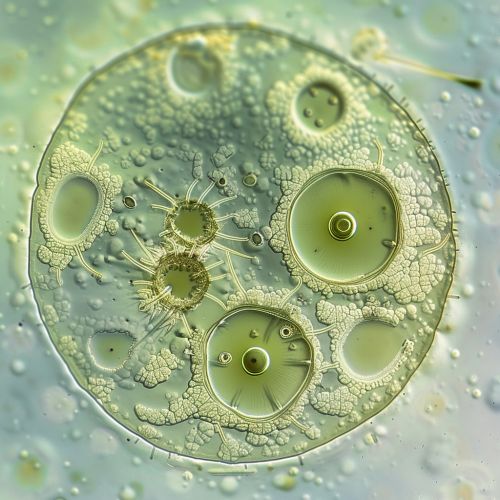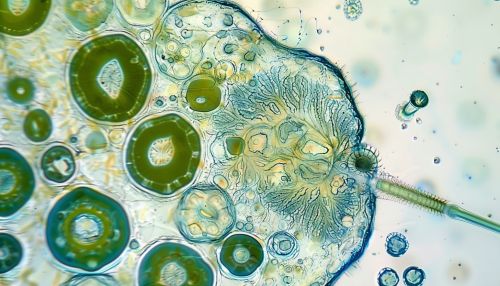Choanocytes: Difference between revisions
(Created page with "== Introduction == Choanocytes, also known as collar cells, are specialized cells found in sponges (phylum Porifera). These cells play a crucial role in the feeding, respiration, and reproduction of sponges. They are characterized by a distinctive collar of microvilli surrounding a single flagellum, which is used to generate water currents and capture food particles. This article delves into the structure, function, and significance of choanocytes in the biology of spong...") |
No edit summary |
||
| Line 7: | Line 7: | ||
The flagellum extends from the center of the collar and is responsible for generating water currents. The beating of the flagellum creates a flow of water through the sponge's body, facilitating the capture of food particles and the removal of waste products. The coordinated movement of the flagella in a sponge's choanocytes is essential for maintaining the flow of water through the sponge's canal system. | The flagellum extends from the center of the collar and is responsible for generating water currents. The beating of the flagellum creates a flow of water through the sponge's body, facilitating the capture of food particles and the removal of waste products. The coordinated movement of the flagella in a sponge's choanocytes is essential for maintaining the flow of water through the sponge's canal system. | ||
[[Image:Detail-92477.jpg|thumb|center|Microscopic image of a choanocyte showing the cell body, collar of microvilli, and flagellum.|class=only_on_mobile]] | |||
[[Image:Detail-92478.jpg|thumb|center|Microscopic image of a choanocyte showing the cell body, collar of microvilli, and flagellum.|class=only_on_desktop]] | |||
== Function == | == Function == | ||
Latest revision as of 10:38, 14 June 2024
Introduction
Choanocytes, also known as collar cells, are specialized cells found in sponges (phylum Porifera). These cells play a crucial role in the feeding, respiration, and reproduction of sponges. They are characterized by a distinctive collar of microvilli surrounding a single flagellum, which is used to generate water currents and capture food particles. This article delves into the structure, function, and significance of choanocytes in the biology of sponges.
Structure
Choanocytes are distinguished by their unique morphology, which includes a cell body, a collar of microvilli, and a single flagellum. The cell body contains the nucleus and other organelles necessary for cellular function. The collar is composed of microvilli, which are finger-like projections that form a mesh-like structure around the flagellum. This collar is instrumental in trapping food particles from the water.
The flagellum extends from the center of the collar and is responsible for generating water currents. The beating of the flagellum creates a flow of water through the sponge's body, facilitating the capture of food particles and the removal of waste products. The coordinated movement of the flagella in a sponge's choanocytes is essential for maintaining the flow of water through the sponge's canal system.


Function
Choanocytes serve several vital functions in sponges, including feeding, respiration, and reproduction.
Feeding
The primary function of choanocytes is to capture and ingest food particles from the water. As the flagellum beats, it generates a water current that draws water through the sponge's pores and into the internal canals. The collar of microvilli traps food particles, such as bacteria and plankton, from the water. These particles are then engulfed by the choanocyte through phagocytosis and digested within food vacuoles.
Respiration
Choanocytes also play a role in respiration by facilitating the exchange of gases. As water flows through the sponge, oxygen is absorbed, and carbon dioxide is expelled. The constant flow of water maintained by the choanocytes ensures that the sponge's cells receive a steady supply of oxygen and can efficiently remove waste gases.
Reproduction
In some sponges, choanocytes are involved in sexual reproduction. They can transform into sperm cells, which are released into the water and taken up by other sponges. The sperm cells then fertilize eggs within the sponge, leading to the development of larvae. These larvae eventually settle and grow into new sponges.
Evolutionary Significance
Choanocytes are of particular interest to evolutionary biologists due to their resemblance to choanoflagellates, a group of free-living unicellular and colonial flagellates. Choanoflagellates are considered the closest living relatives of animals, and the similarities between choanocytes and choanoflagellates provide insights into the early evolution of multicellular organisms.
The presence of choanocytes in sponges suggests that these cells may have been an important step in the transition from unicellular to multicellular life. The ability to generate water currents and capture food particles would have conferred a significant advantage, allowing early multicellular organisms to efficiently obtain nutrients and oxygen.
Ecological Role
Sponges, and by extension choanocytes, play a crucial role in aquatic ecosystems. By filtering large volumes of water, sponges contribute to water clarity and quality. They remove bacteria, plankton, and organic matter from the water, which helps maintain the balance of microbial populations and nutrient cycles.
Additionally, sponges provide habitat and shelter for a variety of marine organisms. The complex structure of a sponge's body, with its numerous canals and chambers, offers refuge for small invertebrates and microorganisms. This enhances biodiversity and supports the overall health of marine ecosystems.
Research and Applications
The study of choanocytes and sponges has led to several important discoveries and applications in various fields of science and technology.
Biomedical Research
Sponges produce a wide range of bioactive compounds, many of which have potential applications in medicine. Researchers have identified compounds with antibacterial, antiviral, and anticancer properties. Understanding the biology of choanocytes and their role in sponge physiology can aid in the discovery and development of new pharmaceuticals.
Environmental Monitoring
Sponges are sensitive to changes in their environment, making them useful indicators of water quality and ecosystem health. The presence and condition of sponges can provide valuable information about pollution levels, water temperature, and other environmental factors. Monitoring choanocyte activity and sponge populations can help scientists assess the impact of human activities on marine ecosystems.
Conclusion
Choanocytes are essential components of sponge biology, playing key roles in feeding, respiration, and reproduction. Their unique structure and function provide insights into the early evolution of multicellular organisms and highlight the ecological importance of sponges in aquatic ecosystems. Ongoing research into choanocytes and sponges continues to reveal new applications and deepen our understanding of these fascinating cells.
